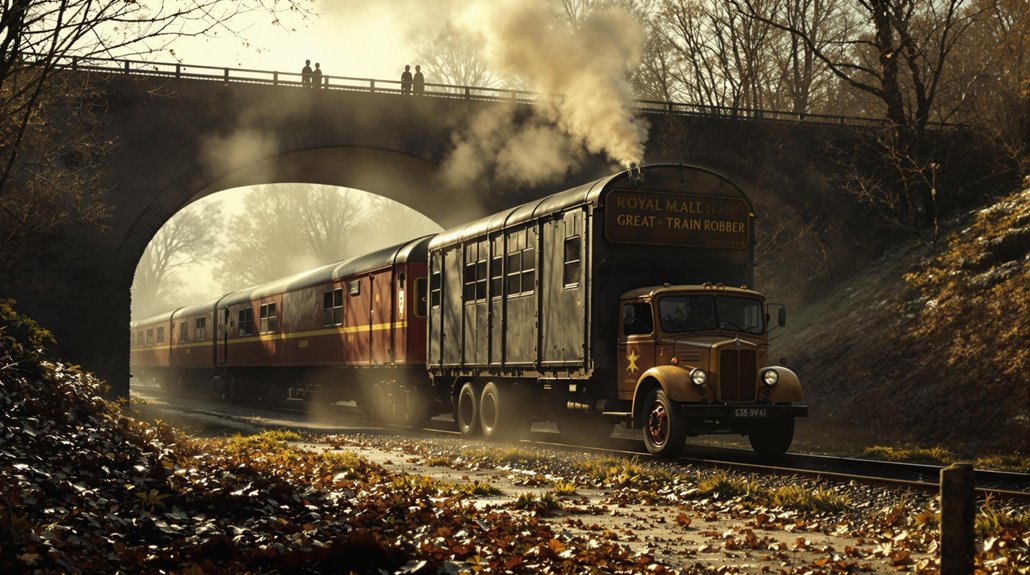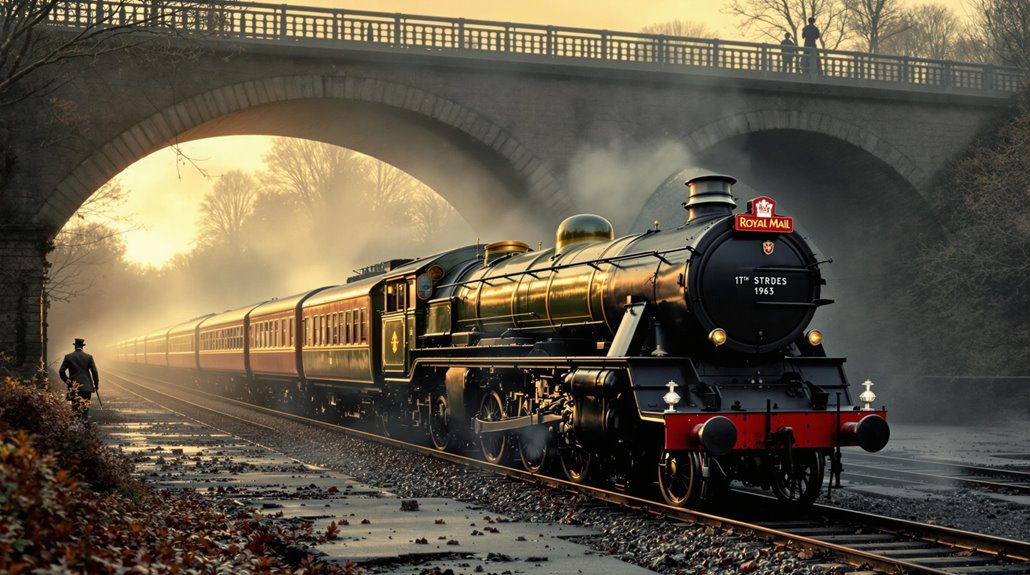The Great Train Robbery of 1963: A Heist That Shocked Britain
You might be surprised to learn that the Great Train Robbery of 1963 wasn't initially meant to target a train at all. Bruce Reynolds and his gang had originally planned to rob a bank, but a tip from an inside source changed everything. What unfolded next would become one of Britain's most daring heists, involving a complex web of police informants, postal workers, and career criminals who'd pull off the equivalent of £55 million in today's money.
The Mastermind's Perfect Plan

While many heists are hastily planned, Bruce Reynolds left nothing to chance when orchestrating Britain's most infamous train robbery.
Reynolds' strategy involved meticulous research, including joining a local fishing club to scout the Bridego Bridge location and filming passing trains to study their patterns.
His tactical execution was equally precise. He assembled a skilled team of 15-16 members, including an electrician to manipulate signals, and secured a farmhouse hideout 27 miles from the target. The gang's total haul reached an astounding £2.6 million in cash.
You'll find every detail was calculated – from cutting phone lines and rigging track lights to arranging getaway vehicles at the bridge. He even timed the heist for 3:00 AM to maximize darkness and planned for the gang to disconnect specific train carriages.
Each team member had false identities and cleanup procedures were established for after the robbery. The gang successfully stole 120 bags of money which they loaded onto their waiting vehicles at Pego Bridge.
Inside the Night of the Heist
Under the cover of darkness on August 7, 1963, Britain's most audacious train heist unfolded as the Glasgow-to-London mail train steamed through Buckinghamshire.
At 3:03 am, the train screeched to a halt near Sears Crossing, where 15-20 masked men had tampered with railway signals, forcing the driver to stop.
You'd have witnessed a precisely orchestrated attack: the robbers had cut telephone lines, immobilized postal workers, and brutally assaulted driver Jack Mills with an iron bar.
In just 15 minutes, they'd seized 120-125 bags of registered mail containing £2.6 million – equivalent to $58 million today.
Without firing a single shot, they transferred their loot to waiting vehicles on a bridge above a country road, marking the first attack on a traveling post office in 125 years. The assailants proceeded to detach the first two cars from the main train and forced engineer Jack Mills to drive to Bridego Bridge for the transfer. The gang later hid at Leatherslade Farm to divide their stolen fortune.
The Fatal Mistakes at Leatherslade Farm
After executing Britain's most daring train heist, the gang's fatal mistakes at Leatherslade Farm would ultimately seal their fate.
Despite their attempts to clean the hideout, you'd be amazed at how many essential pieces of evidence they left behind. Their cleanup failures included overlooked fingerprints on a ketchup bottle and Monopoly board, while they inexplicably abandoned £100,000 in small bills and poorly concealed their hastily painted yellow truck. The gang's rushed escape was prompted when they learned the police search radius had been misreported by the press.
Chief Superintendent Malcolm Fewtrell led the meticulous investigation that would unravel their criminal enterprise.
Witness accounts proved equally damaging to their escape. A local herdsman's tip about suspicious activity, combined with John Maris's testimony and reports from observant shopkeepers, helped police track down the farm just five days after the robbery.
The abundance of physical evidence discovered there, including postal sacks, banknote wrappers, and personal belongings, became instrumental in securing multiple convictions.
The Hunt and Capture of Britain's Most Wanted
Before daybreak on August 8, 1963, Chief Superintendent Malcolm Fewtrell launched Britain's largest manhunt, following the discovery of the ransacked mail train at 4:15 AM.
The police's initial investigation revealed a sophisticated operation involving 15 hooded men, leading them to focus their search within a 30-mile radius of the crime scene. The robbers had used blue boiler suits during the heist to conceal their identities.
Detective Chief Superintendent Tommy Butler's breakthrough came when he leveraged criminal networks to gather intelligence.
Two key informants proved essential – a provincial jail inmate who provided 18 names and a woman who filled critical information gaps.
Despite objections, the police tactics of publishing suspects' photos proved effective. The strategy led to several high-profile arrests, including Brian Field, Roy James, and Ronald Biggs.
By January 1964, authorities had captured twelve suspects, with the ringleaders receiving 30-year sentences.
Eventually, 17 men were convicted for their roles in the heist. The investigation team discovered crucial evidence at Leatherslade Farm, including bank note wrappers and fingerprints that helped secure convictions.
A Legacy That Changed British Crime History

The Great Train Robbery's four major impacts revolutionized British crime history and law enforcement.
The heist transformed policing by leading to the creation of the Flying Squad and advancing forensic techniques, while exposing critical weaknesses in security protocols.
The robbery's societal impact reached far beyond its £2.6 million haul.
You'll find its influence in countless books, films, and TV shows, cementing its place in British folklore as the "Crime of the Century."
The case changed how criminals approached large-scale heists, introducing new criminal techniques that emphasized planning and insider information over violence.
The thieves' ingenious method of using gloves and batteries to manipulate train signals demonstrated unprecedented sophistication in railway crime.
 Bruce Reynolds' leadership, the gang's meticulous planning and execution set new standards for organized crime operations.
Bruce Reynolds' leadership, the gang's meticulous planning and execution set new standards for organized crime operations.
The robbery's influence on law enforcement and organized crime continues to shape Britain's criminal landscape.










